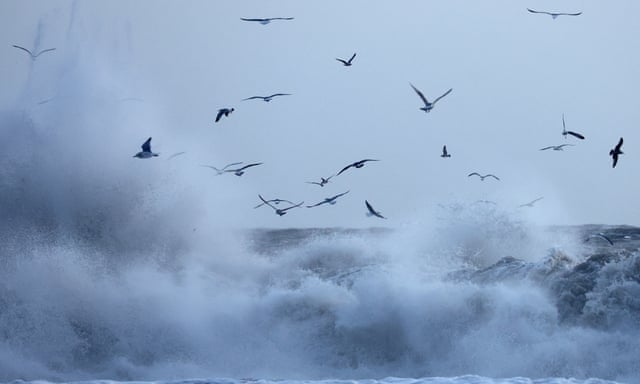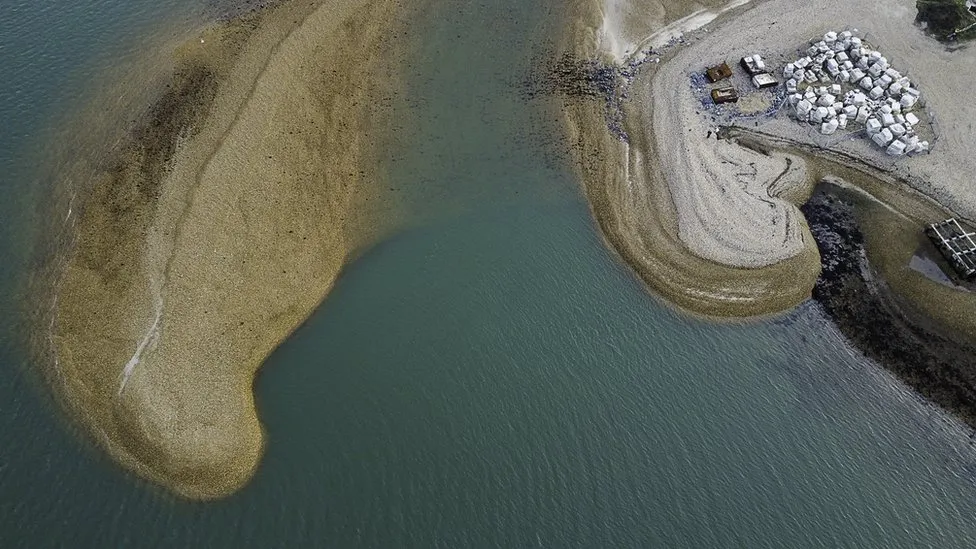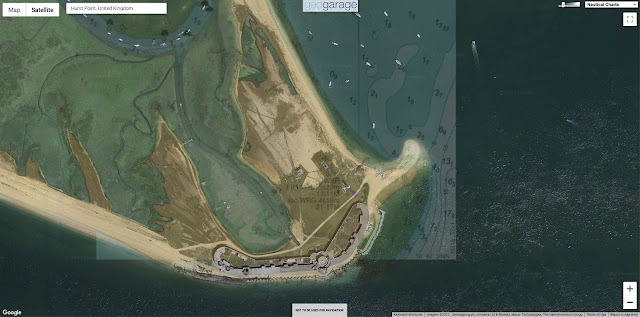Like a magic moment, like the concretization of a year and a half of work, the IMOCA Paprec Arkéa took its first flight on Wednesday off Lorient La Base, with Yoann Richomme and the Paprec Arkéa Team on board.
Saturday, March 18, 2023
Friday, March 17, 2023
Glassy fangs and glowing fins: amazing deep sea animals found near Cocos Islands
A ferocious looking conger eel with large fang-like teeteh was collected from a depth of 1,000 metres.
Photograph : Benjamin Heally/Museums Victoria
From The Guardian by Helen Scales
Discovered in the deep: Scientists exploring the uncharted waters of the Indian Ocean uncover a multitude of dazzling sea creatures around a remote Australian island group
Ashipload of scientists has just returned from exploring the uncharted waters of the Indian Ocean, where they mapped giant underwater mountains and encountered a multitude of deep-sea animals decked out in twinkling lights, with velvety black skin and mouths full of needle-sharp, glassy fangs.
Cocos (Keeling) Islands on the GeoGarage platform (UKHO nautical raster chart)
The team of biologists was the first to study the waters around the Cocos (Keeling) Islands, an Australian territory more than 600 miles off the coast of Sumatra.
“It’s just a complete blank slate,” says the expedition’s chief scientist, Dr Tim O’Hara, from Museum Victoria Research Institute.
“That area of the world is so rarely studied,” says Dr Michelle Taylor from the University of Essex and president of the Deep-Sea Biology Society, who wasn’t involved in the expedition.
Few research expeditions make it to the Indian Ocean, chiefly because it’s so remote.
It took the team six days to get to Cocos (Keeling) Islands from Darwin, in Australia’s Northern Territory, on the research vessel Investigator, operated by Australia’s national science agency, CSIRO.

The Sloane’s viperfish has huge fang-like teeth, visible even when the mouth is closed.
It has light-producing organs on its belly and upper fin, which help disguise it from predators and lure prey.
Photograph: Benjamin Healley
It has light-producing organs on its belly and upper fin, which help disguise it from predators and lure prey.
Photograph: Benjamin Healley
“The real stars of the show are the fish,” says O’Hara, who specialises in invertebrates.
“There are blind eels and tripod fish, hatchetfish and dragonfish, with all of these bioluminescent organs on them and lures coming out of their heads.
They’re just extraordinary.”“There are blind eels and tripod fish, hatchetfish and dragonfish, with all of these bioluminescent organs on them and lures coming out of their heads.
Among the huge variety of life they found, the deep-sea batfish was a highlight.
It sits on the seabed like an ornate pancake and struts about on two stubby fins that act as legs.
It wiggles a tiny lure tucked into a hollow on its snout, presumably hoping to trick prey into thinking it is a tasty worm.
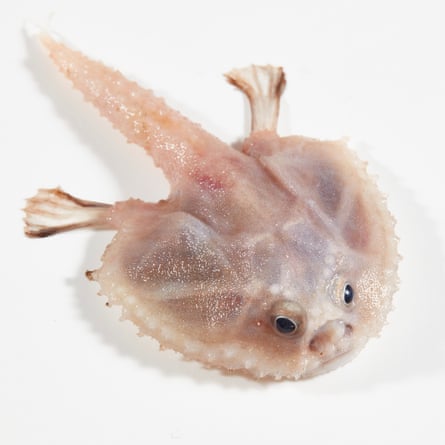

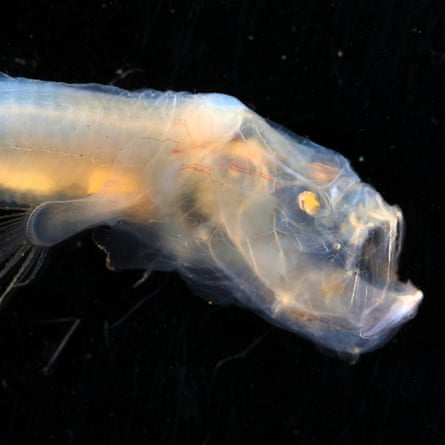
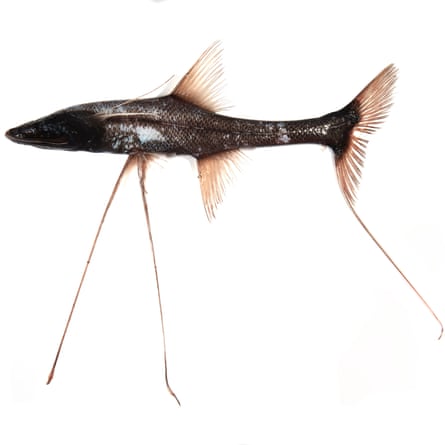
Clockwise from top left: a deep-sea batfish; a voracious highfin lizard fish; tribute spiderfish on its ‘stilts’; a previously unknown blind eel.
Photographs: Benjamin Healley
Photographs: Benjamin Healley
They spotted the tribute spiderfish, which has long lower fins it uses as stilts to perch above the seabed, catching passing morsels of food.
They found a previously unknown blind eel, collected from 5,000m down, covered in jelly-like, transparent skin.
And they saw stoplight loose jaws, a type of dragonfish, which have huge unfolding jaws with double hinges and the unusual habit of spying on other animals with red bioluminescent light, a colour which most deep-sea animals can’t see.
A sampling net dragged across the abyssal plain came up full of ancient shark teeth.
“They were gigantic sharks that lived millions of years ago,” says O’Hara.
Based on photographs, fossil experts think these came from “megalodon-like animals”.
They’ll know more once they get their hands on the teeth, which are now being sent to museums along with all the rest of the collections.
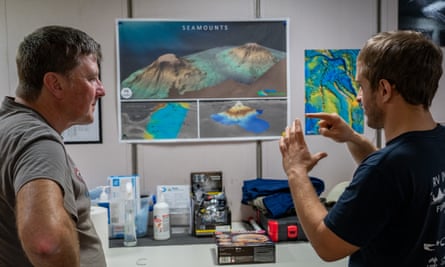
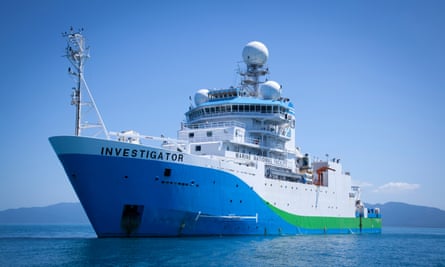
Scientists Nelson Kuna from CSIRO, left, and Tim O’Hara from Museums Victoria.
Right, the RV Investigator.
Photographs: Robert French and Mike Kuhn
Right, the RV Investigator.
Photographs: Robert French and Mike Kuhn
As well as shining a light on the deep-sea life of this unstudied region, the team also uncovered a dramatic seascape, including huge submerged volcanoes, or seamounts, which at 5,000 metres high are more than twice as tall as Australia’s highest land mountain.
“From the surface you wouldn’t know,” says O’Hara.
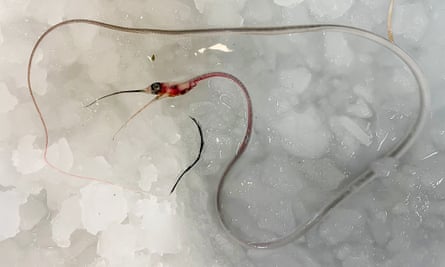
The slender snipe eel, found at depths of up to 4,000m.
With its long tail, it can reach a metre in length.
Curved jaws, permanently open, are covered in tiny hooked teeth that snag their prey.
Photograph: Yi-Kai Tea
With its long tail, it can reach a metre in length.
Curved jaws, permanently open, are covered in tiny hooked teeth that snag their prey.
Photograph: Yi-Kai Tea
Using high-resolution sonar, the team created detailed 3D maps of the deep seafloor, and discovered several smaller seamounts that were previously unknown.
Not only are many deep seamounts covered in rich habitats of corals, sponges and other wildlife, they play a crucial role in mixing the ocean.
Deep currents sweep up the flanks of seamounts, bringing vital nutrients to the surface.
“Some people call them the stirring rods of the oceans because they actually mix water at different levels,” says O’Hara.
One reason for going to the Cocos (Keeling) Islands was to provide baseline information to help manage and protect the newly established marine park there, set up in March 2022 with the nearby Christmas Island marine park, which the team visited last year.
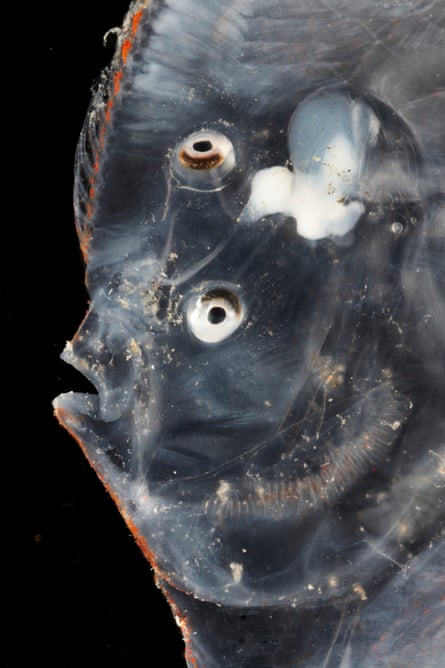
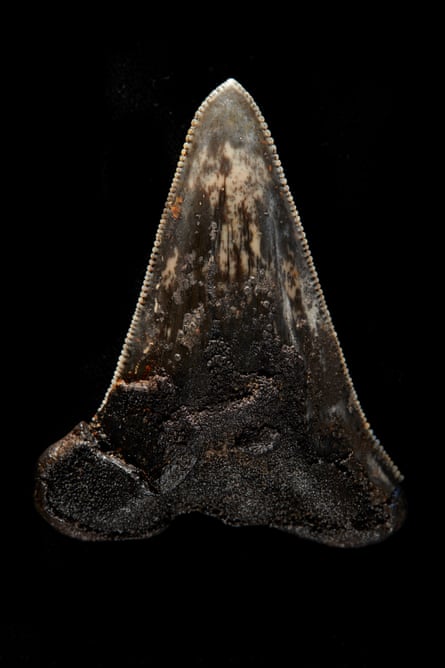
A flatfish from the order Pleuronectiformes, left.
Researchers also found ancient rocks and fossils, such as a tooth from a white shark, right.
Photographs: Benjamin Healley
Researchers also found ancient rocks and fossils, such as a tooth from a white shark, right.
Photographs: Benjamin Healley
The area isn’t threatened by deep-sea mining because, as O’Hara says, geologists prospected for seafloor minerals and decided they weren’t worth exploiting.
The main threat, according the team, was plastic pollution.
“Even when you’re that far off the continent, at four kilometres deep, you’ll dredge up plastics,” he says.
“You see it in the water, you see it on top of the water, and we saw it in our collections.”
It will take years for experts to work their way through all the specimens the expedition collected, but O’Hara estimates that between 10% and 30% will be species new to science.
“I’m really excited about what new future science discoveries come out from this in the years to come,” says Taylor.
One thing the team already has planned is to match up DNA from the specimens with DNA snippets sifted from seawater, known as environmental or eDNA, which is shed by organisms in slime and skin cells.
The idea is that in the future, scientists will be able to identify which species are present in the deep sea just from the genetic calling cards left behind in the seawater.

Deep-sea batfish move over the seafloor on their armlike fins.
They have a tiny “fishing lure” in their snout which they wiggle about to help them attract prey.
Photograph: Benjamin Healley
They have a tiny “fishing lure” in their snout which they wiggle about to help them attract prey.
Photograph: Benjamin Healley
“Who knows what’s going to happen with those specimens in museums in 100 years’ time,” says Taylor.
“Trying to maximise the science possible from each one of the specimens is so important, because it’s such a rare privilege to be able to visit these deep-sea areas.”
Thursday, March 16, 2023
Global Internet connectivity is at risk from climate disasters
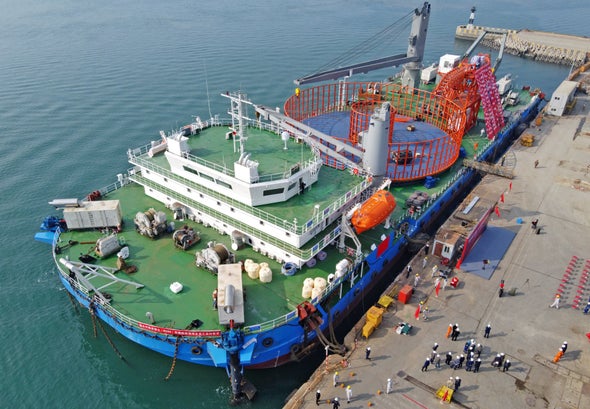
A cable laying ship being readied for departure at a construction base in Yantai, Shandong Province, China.
From Scientific American by Daniel Cusick
Thousands of miles of fiber-optic cable lining the seafloor are vulnerable to sea-level rise, storms and other climate impacts, research shows
The flow of digital information through fiber-optic cables lining the sea floor could be compromised by climate change.
That's according to new research published in the journal Earth-Science Reviews by scientists from the United Kingdom’s National Oceanography Centre and the University of Central Florida.
They found that ocean and nearshore disturbances caused by extreme weather events have exposed “hot spots” along the transglobal cable network, increasing the risk of internet outages.
Damage from such outages could be enormous for governments, the private sector and nonprofit organizations whose operations rely on the safe and secure flow of digital information.
For example, the researchers wrote that intensifying tropical cyclones in the northern Pacific Ocean are stressing submarine cables off the coast of Taiwan, whose sovereignty is under threat as China claims territorial rights over the island.
And in strategically important polar regions, melting glacial and sea ice “are profoundly changing ocean conditions more rapidly than many other places on Earth,” the researchers found.
“Our analysis clearly stresses the need to carefully plan cable routes and landing station locations factoring in a range of local hazards and how those are affected by climate change,” co-author Thomas Wahl, an associate professor in UCF’s Department of Civil, Environmental and Construction Engineering, said in a release.
The findings are drawn from analysis of peer-reviewed data sets on seafloor cable infrastructure and its vulnerability to climate change.
Other collaborators in the study include the U.S. Geological Survey, the University of Southampton, Victoria University of Wellington in New Zealand and the International Cable Protection Committee.
“We find that ocean conditions are highly likely to change on a global basis as a result of climate change, but the feedbacks and links between climate change, natural processes and human activities are often complicated, resulting in a high degree of geographic variability,” the researchers wrote.
Such risks will be particularly compounded by sea-level rise, the authors said, as swelling oceans increase hazard severity, create new hazards and shift hazard risk to new areas.
At the same time, the global subsea cable network continues to expand.
Real-time information from the firm TeleGeography shows a vast network of trans-Atlantic and trans-Pacific lines from the United States to Europe and Asia.
Other continents, such as South America and Africa, are ringed by submarine cables that connect to shorelines at thousands of interconnection points.
While natural disasters that damage subsea cables are “fewer in number than those linked to human activities,” such as bottom fishing or ship anchor strikes, instances of cable damage from natural hazards “can synchronously damage multiple cable systems across large areas, isolating whole regions,” the authors wrote.
That's according to new research published in the journal Earth-Science Reviews by scientists from the United Kingdom’s National Oceanography Centre and the University of Central Florida.
They found that ocean and nearshore disturbances caused by extreme weather events have exposed “hot spots” along the transglobal cable network, increasing the risk of internet outages.
Damage from such outages could be enormous for governments, the private sector and nonprofit organizations whose operations rely on the safe and secure flow of digital information.
For example, the researchers wrote that intensifying tropical cyclones in the northern Pacific Ocean are stressing submarine cables off the coast of Taiwan, whose sovereignty is under threat as China claims territorial rights over the island.
And in strategically important polar regions, melting glacial and sea ice “are profoundly changing ocean conditions more rapidly than many other places on Earth,” the researchers found.
“Our analysis clearly stresses the need to carefully plan cable routes and landing station locations factoring in a range of local hazards and how those are affected by climate change,” co-author Thomas Wahl, an associate professor in UCF’s Department of Civil, Environmental and Construction Engineering, said in a release.
The findings are drawn from analysis of peer-reviewed data sets on seafloor cable infrastructure and its vulnerability to climate change.
Other collaborators in the study include the U.S. Geological Survey, the University of Southampton, Victoria University of Wellington in New Zealand and the International Cable Protection Committee.
“We find that ocean conditions are highly likely to change on a global basis as a result of climate change, but the feedbacks and links between climate change, natural processes and human activities are often complicated, resulting in a high degree of geographic variability,” the researchers wrote.
Such risks will be particularly compounded by sea-level rise, the authors said, as swelling oceans increase hazard severity, create new hazards and shift hazard risk to new areas.
At the same time, the global subsea cable network continues to expand.
Real-time information from the firm TeleGeography shows a vast network of trans-Atlantic and trans-Pacific lines from the United States to Europe and Asia.
Other continents, such as South America and Africa, are ringed by submarine cables that connect to shorelines at thousands of interconnection points.
While natural disasters that damage subsea cables are “fewer in number than those linked to human activities,” such as bottom fishing or ship anchor strikes, instances of cable damage from natural hazards “can synchronously damage multiple cable systems across large areas, isolating whole regions,” the authors wrote.
Nicole Starosielski, an associate professor of media, culture and communications at New York University and author of the book “The Undersea Network,” has noted that today’s submarine cables are built and placed with greater attention to disaster risk.
But many cable stations, where submarine cables terminate after coming ashore, “were built before climate change was a consideration in builders’ minds,” she wrote on the Canadian website Open Canada.
In 2021, the International Cable Protection Committee, comprising industry and government officials, issued a “best practices” document for protecting and promoting resilience of submarine telecommunications cables.
Among its recommendations was to disperse cable infrastructure to provide redundancy and backup measures during extreme events.
The committee also co-published a report in 2009 with the United Nations Environment Programme that said rising seas could worsen erosion and increase flood risk of onshore coastal cable facilities.
In hurricane and typhoon zones, severe storms “will not only attack the coast, but also influence the stability of the continental shelf seabed via the formation of eroding currents and waves," the report said.
Such action could expose cables to more abrasion or suspensions above the seabed, as well as trigger submarine landslides and greater turbidity.
Mike Clare, the study’s lead author and a researcher at the National Oceanography Centre, said it's essential that scientists and engineers assess new potential disruptions that may emerge with climate change.
“Our reliance on cables that are no wider than a garden hose is a surprise to many, who regard satellites as the main means of communication,” Clare said in a release.
“But satellites simply don’t have the bandwidth to support modern digital systems.
The ‘cloud’ is not in the sky — it is under the sea.”
But many cable stations, where submarine cables terminate after coming ashore, “were built before climate change was a consideration in builders’ minds,” she wrote on the Canadian website Open Canada.
In 2021, the International Cable Protection Committee, comprising industry and government officials, issued a “best practices” document for protecting and promoting resilience of submarine telecommunications cables.
Among its recommendations was to disperse cable infrastructure to provide redundancy and backup measures during extreme events.
The committee also co-published a report in 2009 with the United Nations Environment Programme that said rising seas could worsen erosion and increase flood risk of onshore coastal cable facilities.
In hurricane and typhoon zones, severe storms “will not only attack the coast, but also influence the stability of the continental shelf seabed via the formation of eroding currents and waves," the report said.
Such action could expose cables to more abrasion or suspensions above the seabed, as well as trigger submarine landslides and greater turbidity.
Mike Clare, the study’s lead author and a researcher at the National Oceanography Centre, said it's essential that scientists and engineers assess new potential disruptions that may emerge with climate change.
“Our reliance on cables that are no wider than a garden hose is a surprise to many, who regard satellites as the main means of communication,” Clare said in a release.
“But satellites simply don’t have the bandwidth to support modern digital systems.
The ‘cloud’ is not in the sky — it is under the sea.”
Links :
- GeoGarage blog : The threat to world's communications backbone / A deep dive into risks for undersea cables, pipes / The most vulnerable place on the Internet / Norwegian undersea surveillance network had its cables ...
- TechMonitor : Could undersea cables be the next casualty of hybrid warfare?
- CircleID : Submarine Cable Resiliency in the Face of Disruptions
- JapanNews : Security for Japan Also Means Protecting Underwater Cables
- EurAsian Times : Undersea Internet Cables Connecting Taiwan To Its Islands Cut Twice! Coincidence Or Chinese Handiwork?
Wednesday, March 15, 2023
Not a breath of fresh air: study finds sewage bacteria in ocean spray
Ocean spray can carry sewage bacteria into coastal communities, new research has shown.
Photograph: Mario Tama/Getty Images
Photograph: Mario Tama/Getty Images
From The Guardian by Katharine Gammon
Pathogens such as E coli, norovirus and salmonella can be blown miles into coastal communities after a rainstorm
After a rainstorm passes, the air coming off the ocean just feels different – cleaner and fresher.
But a first of its kind study shows how bacteria from sewage in the ocean can get whipped up in salt spray and blow into coastal communities miles away, a phenomenon exacerbated by storm runoff.
The study, released on Thursday by researchers at the Scripps Institution of Oceanography, looked at an area south of San Diego near the US-Mexico border, where a Mexican wastewater treatment plant often becomes overwhelmed and spews sewage into the Tijuana River.
That river then flows north into Imperial Beach on the northern side of the border.
The beach there was closed 249 days last year due to high levels of pathogens like E coli, norovirus and salmonella – but until now, little was known about what happened when crashing waves sent salt spray into the air.
A team of researchers sampled coastal aerosols at Imperial Beach and water from the Tijuana River for 26 days between January and May 2019, focusing on times after storms.
They used DNA sequencing to match bacteria and chemical compounds in coastal aerosols back to the sewage-polluted Tijuana River flowing into the ocean.
They found that three-quarters of the bacteria in the air came directly from the sewage in the surf zone.
It’s not yet clear whether these bacteria can make people sick, and experts are exploring the possible harms.
“Are they potentially infectious? Some are pathogens and some are not.
That’s something we’re working on now,” says Kim Prather, an atmospheric chemist at Scripps who led the work, which was published today in the journal Environmental Science and Technology.
While the degree of risks remain unknown, the study is significant because it is the first time scientists have linked such pollution to coastal sea spray.
It’s also the first time scientists have been able to quantify how much of the microbes in the air are traceable back to microbes in the sewage contaminated water, says Rob Knight, a researcher at San Diego School of Medicine and Jacobs School of Engineering, who worked on the study.
“Now we know this is a real phenomenon, we need to figure out the impacts for human health,” he says.
Prather adds that these pathogens are typically thought of as food borne or waterborne.
“There has been a huge focus on them being in the water, and not so much in the air,” she says.
“We really don’t have any studies that say what would happen if you inhale these, this is a different exposure pathway than we have thought about, that anybody has thought about, before.”
The team found the pathogens present a mile or two inland – and there is evidence that coastal salt spray can be blown hundreds of miles inland, but particles get more dispersed as they move away from the coast, Prather says.
“We don’t know what the effect is yet of inhaling this cocktail that comes out of the ocean – it’s something we are trying to understand.” They are currently in the process of starting another study in the area that would spend 40 straight days sampling the air for bacteria, viruses and chemicals stemming from water pollution.
Surfers head out to waves in Imperial Beach, California, where researchers monitored the air and water after storms.
Photograph: Eduardo Contreras/AP
Photograph: Eduardo Contreras/AP
Aerosols have been a hot topic in recent years, because of the nature of Covid-19 – but environmental scientists have been studying aerosols like wildfire smoke or sea spray for decades.
When waves break, about 20% of the bacteria present break off easily from the water and bubble up into the air.
Prather describes the process as a “hydrophobic goo that doesn’t like water, so it will almost float like oil on the surface of the ocean”.
When waves crash and bubbles burst, that material launches into the air.
Storms also release a huge amount of raw sewage into our waterways – from pet waste on streets to treatment plants that can flood like the one in Mexico.
If the surf is high and there’s a lot of white foam, the conditions are primed for bacteria to be sent spewing into the air, says Prather.
In just the past few weeks alone, during a series of brutal rainstorms in California that began on 28 December, an estimated 13bn gallons of raw sewage have been released into the waters around San Diego.
“So there’s a lot more microbes in the water right now – more than maybe ever before.”
Matthew Pendergraft, a recent graduate from Scripps Oceanography who obtained his doctorate under the guidance of Prather, says that rain should clean out any air pollution, but it comes down to an infrastructure problem that’s causing the polluted water.
“This research demonstrates that people in coastal communities like Imperial Beach are exposed to coastal water pollution even without entering that water.
Basic aerosol science states that these aerosols will travel further downwind than just on the beach.”
After storms, bacterial levels can remain elevated for three days or more, according to the LA county department of public health.
Prather says she thinks about air quality every time a beach is closed due to high levels of bacteria in the water, and she could see a future where warning signs are posted about breathing salty air on those days.
“The dream would be to determine certain conditions where it’s bad to breathe the air,” she says.
“We’d be able to do warnings for the public – just alerts like we do for high pollution days, where people who have sensitive lungs or young kids should be more cautious.”
Tuesday, March 14, 2023
These startups hope to spray iron particles above the ocean to fight climate change

An artist's rendering of a commercial-scale release of iron-salt particles above the ocean.
Stephanie Arnett/MITTR
From MIT by James Temple
The intervention may break down methane, mimicking a phenomenon that could have amplified ice ages.
But scientists say far more basic research still needs to be done.
Within the next 18 months, a Palo Alto–based startup wants to begin releasing a small quantity of iron-rich particles into the exhaust stream of a shipping vessel crossing the open ocean.
Blue Dot Change hopes to determine whether the particles will accelerate the destruction of methane, one of the most powerful greenhouse gases in the atmosphere.
If it works, the four-person company hopes to begin spraying the particles on commercial scales within a year after that, says David Henkel-Wallace, the founder and chief executive.
The business is among a handful of small commercial ventures that are itching to test whether releasing similar particles could curb climate change, mimicking a phenomenon that some believe may have amplified ice ages.
At least two other firms have also proposed outdoor experiments to evaluate this approach, MIT Technology Review has found.
There’s increasing academic work exploring this concept as well, driven by growing climate concerns and rising emissions of methane, which exerts about 85 times the warming effect of carbon dioxide over a 20 year-period.
But most scientists in this area stress that the iron idea is speculative, limited so far to early lab and modeling work.
Little is known about other effects that releasing the particles could cause, including potentially dangerous ones.
And some argue that for-profit efforts to intervene in such a complex, little-understood area is rash and counterproductive at this stage.
“Any commercial venture that proposes we’re ready to do this in the field is premature and possibly misguided,” says Rob Jackson, a professor of Earth system science at Stanford, without addressing any specific company’s plans.
“We don’t know enough about it. We don’t know enough about unexpected or unpredicted reactions.
And we don’t know about social acceptance and the public’s view of this process.”
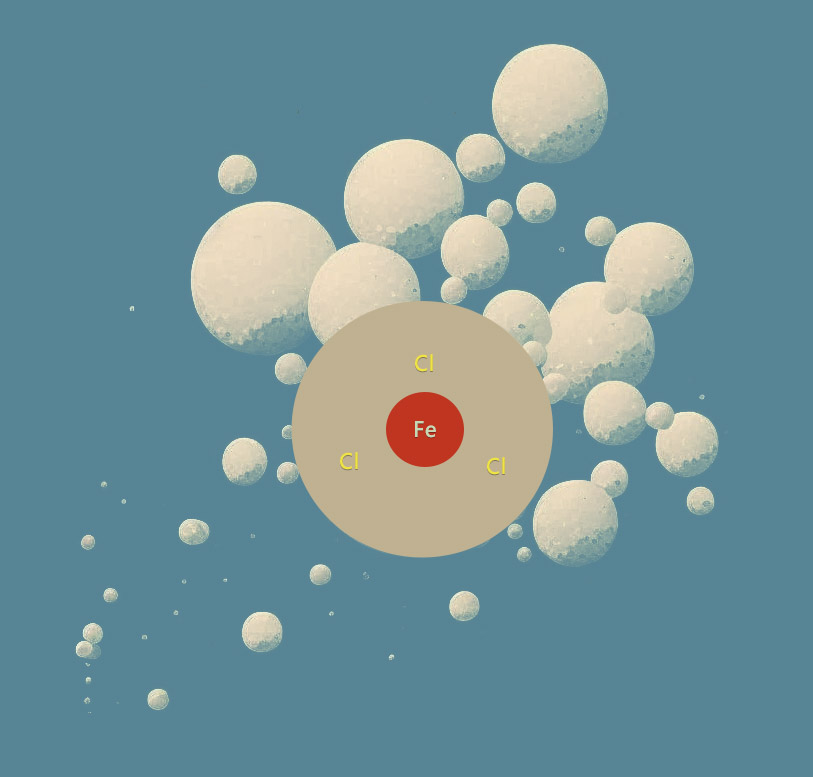 S
Several startups hope that releasing tiny particles of ferric chloride (FeCl3) could accelerate the destruction of methane in the atmosphere.
The basic concept behind the so-called iron salt aerosol method is that if we release iron-rich particles that contain chloride into the air, sunlight will irradiate them, producing chlorine radicals (uncharged molecules with an electron available for bonding).
These, in turn, can drive reactions that convert methane into carbon dioxide in the atmosphere.
But it’s also possible the same particles could produce dangerous gases, spawn phytoplankton blooms, or brighten marine clouds, the last of which would muddy the line between greenhouse-gas removal and the more controversial field of solar geoengineering.
In addition, the chemistry is so complex that it’s not clear to some whether releasing these aerosols would increase or decrease methane concentrations, on balance.
“We have no idea what will happen there,” says Natalie Mahowald, an atmospheric scientist at Cornell and an expert on iron aerosols.
99.9%
Peter Fiekowsky, an engineer and entrepreneur who cofounded the Foundation for Climate Restoration, has emerged as a kind of Pied Piper of the iron salt aerosol method, advocating for groups to forge ahead in this field.
He has funded academic research, acts as an advisor to several startups and is listed as a shareholder in one.
He has also established a handful of related organizations himself.
Fiekowsky argues that resigning ourselves to merely meeting the UN climate panel’s temperature target, mainly through emissions cuts, doesn’t offer humanity “a decent chance of survival.”
(That goal is set at a maximum of 2 ˚C above preindustrial levels, which will have severe impacts on humans and ecosystems, and could trigger certain climate tipping points.
But the body of research doesn’t suggest that level of warming creates a risk of human extinction.)
Instead, Fiekowsky says, we should strive to restore the climate to preindustrial conditions through more aggressive interventions, including using iron to break up methane.
“Methane is really only important once you take on [the goal] of restoring the climate and making sure our kids survive,” he says.
Fiekowsky shares few of the doubts about iron salt aerosols or the wisdom of using them, asserting that the approach is safe, effective, cheap, and inevitable.
He says it would cost only $1 billion per year to cut methane concentrations in half this way and puts the method’s odds of real-world success at 99.9%.
“How can I justify that?” he wrote in a follow-up email to MIT Technology Review.
“A project only fails when people stop working on it. We’re not going to stop until we succeed. Period. That’s how we won WWII. That’s why I give us a 99.9% chance of success. The 0.1% chance of failure would be a nuclear war killing us first.”
With statements like these, Fiekowsky has earned a reputation as someone who passionately cares about addressing the problem but speaks with “overconfident grandiosity” about the effectiveness of certain solutions and the urgency of deploying them, says Ted Parson, an environmental law professor at the University of California, Los Angeles.
“He’s been, in my view, quick to assume that scientists and other researchers are overly cautious and dotting every ‘i’ and crossing every ‘t,” Parson says.
“He wants to plunge ahead and solve the problem, and I’m concerned there’s not enough information about this yet to be confident it’s an effective and safe solution.”
But the body of research doesn’t suggest that level of warming creates a risk of human extinction.)
Instead, Fiekowsky says, we should strive to restore the climate to preindustrial conditions through more aggressive interventions, including using iron to break up methane.
“Methane is really only important once you take on [the goal] of restoring the climate and making sure our kids survive,” he says.
Fiekowsky shares few of the doubts about iron salt aerosols or the wisdom of using them, asserting that the approach is safe, effective, cheap, and inevitable.
He says it would cost only $1 billion per year to cut methane concentrations in half this way and puts the method’s odds of real-world success at 99.9%.
“How can I justify that?” he wrote in a follow-up email to MIT Technology Review.
“A project only fails when people stop working on it. We’re not going to stop until we succeed. Period. That’s how we won WWII. That’s why I give us a 99.9% chance of success. The 0.1% chance of failure would be a nuclear war killing us first.”
With statements like these, Fiekowsky has earned a reputation as someone who passionately cares about addressing the problem but speaks with “overconfident grandiosity” about the effectiveness of certain solutions and the urgency of deploying them, says Ted Parson, an environmental law professor at the University of California, Los Angeles.
“He’s been, in my view, quick to assume that scientists and other researchers are overly cautious and dotting every ‘i’ and crossing every ‘t,” Parson says.
“He wants to plunge ahead and solve the problem, and I’m concerned there’s not enough information about this yet to be confident it’s an effective and safe solution.”
‘Danger zone’
Despite their deep concerns over efforts to commercialize the concept at this point, Jackson and other scientists are in favor of careful, early-stage research exploring the potential to break down atmospheric methane, whether using iron salt aerosols or other methods.
Carbon dioxide has long overshadowed methane in the climate dialogue, because it plays a much larger overall role in driving warming.
But methane has gained attention as emissions of the gas from industrial sources, burping cattle, deforestation, and natural systems like wetlands have climbed sharply over the past decade.
At the same time, nations are not on pace to cut carbon dioxide emissions fast enough to avoid 2 ˚C of warming or more, even as the world grapples with increasingly severe wildfires, heat waves, and floods.
Because methane is so powerful and persists in the atmosphere for such a short period—years, compared with centuries for carbon dioxide—cutting emissions or destroying the gas in the air offers one of the few mechanisms we may have to meaningfully reduce near-term warming.
A 40% decrease in methane concentrations by 2050 would shave about 0.4 °C off global warming, a 2021 study found.
“We’re on a warming trajectory of increasing human costs and Earth system risks, and in that danger zone, every fraction of a degree matters,” wrote Erika Reinhardt, the cofounder of Spark Climate Solutions, a San Francisco–based nonprofit, in an email.
Spark supports research in early-stage but probably crucial climate responses, including destruction or removal of methane in areas where it’s concentrated—like landfills and dairy farms—as well as in the open atmosphere.
It has provided funding for a research collaboration that is doing a variety of atmospheric sampling, computer modeling, and lab work exploring the iron salt aerosol hypothesis.
It includes scientists from the University of Copenhagen, Utrecht University, the Spanish National Research Council, and Cornell, including Mahowald.
But like others, Reinhardt stressed that the research is far too preliminary for commercial ventures to begin forging ahead.
“It’s an incredibly early field where there are still more questions than answers, but the questions are wildly important ones as we work to reduce climate risk,” she said.
The ‘iron hypothesis’
The general idea that iron may play a major role in dramatic climate shifts dates back decades.
During a 1988 lecture, the renowned oceanographer John Martin famously declared: “Give me a half tanker of iron, and I will give you an ice age.”
His “iron hypothesis,” put forth in a landmark 1990 paper, was that as the planet cooled during glacial periods, stronger winds picked up dust from drying continents and carried it deep into the oceans.
Iron makes up about 3.5% of dust, and as the mineral reached the seas, it might have spawned massive phytoplankton blooms.
These, in turn, would have sucked up carbon dioxide and buried it in the ocean, magnifying cooling.
It was a highly controversial concept at the time, but multiple lines of evidence in a growing body of research have backed it up over the ensuing decades.
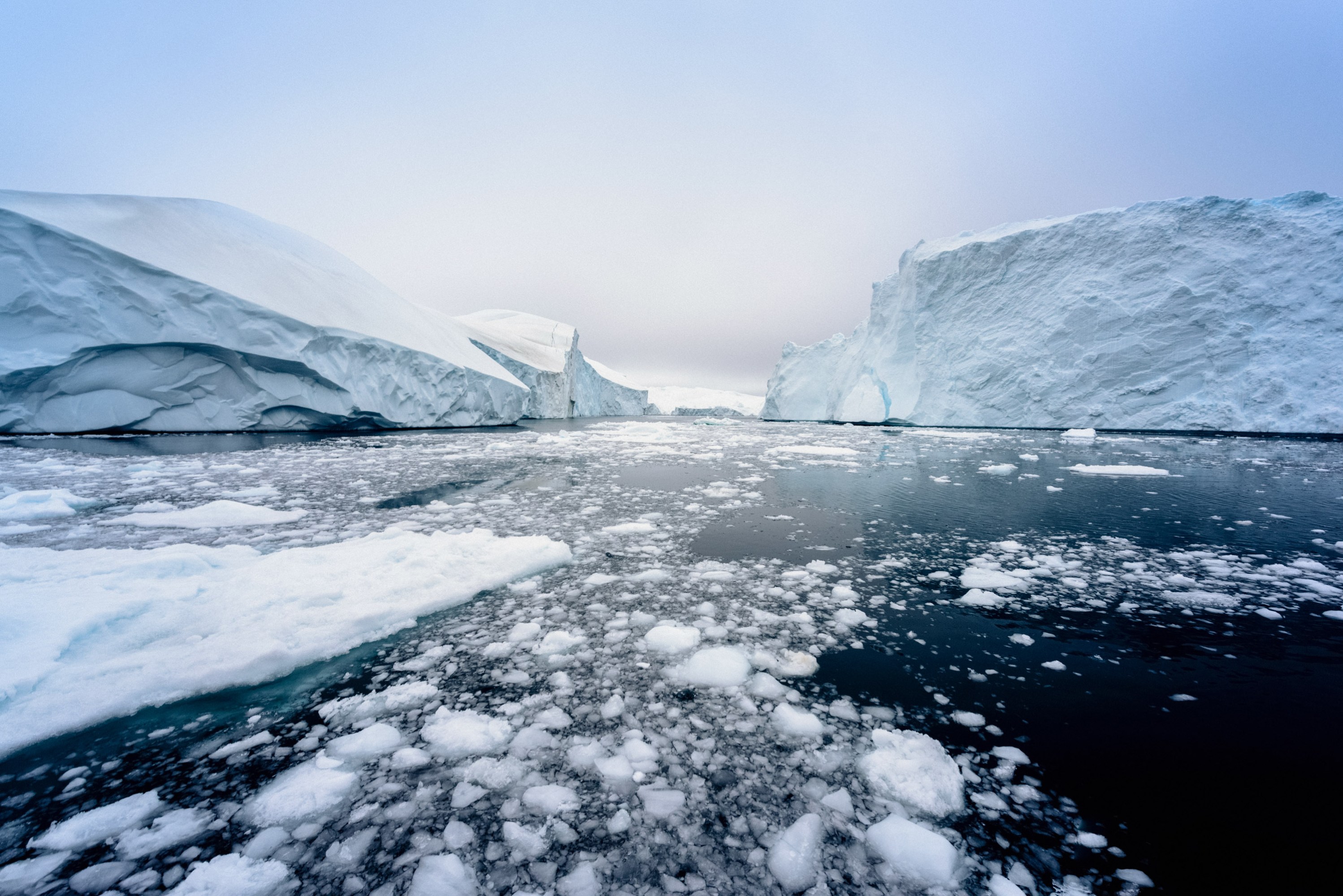 Icebergs and sea ice floating near the coast of Greenland.
Icebergs and sea ice floating near the coast of Greenland.Getty Images
A number of research groups and several commercial ventures have explored whether “ocean iron fertilization”—adding iron particles directly into the water—would work as a deliberate means of removing carbon dioxide from the atmosphere and reducing warming.
Methane levels also dropped during these glacial periods, ice core samples show.
One hypothesis is that the same dust may have played a role as the iron reacted with salty air above the oceans, producing chloride-rich iron particles.
Several lab studies have found that sunlight, or at least an artificial version of it, induces reactions that produce chlorine from these sorts of particles.
Chlorine is responsible for breaking down about 3% to 4% of methane in the atmosphere, converting it into carbon dioxide.
Because that’s a much less powerful greenhouse gas, the overall warming effect is significantly reduced.
In a 2017 paper and several others, independent researchers Franz Dietrich Oeste, Renaud de Richter, and additional collaborators raised the possibility of mimicking this process as a means of “climate engineering.”
The paper goes further, stating that iron particles could drive a variety of other potential cooling effects, including fertilizing the oceans as Martin described.
They might also produce more—and more reflective—marine clouds, by providing nuclei that water vapor can condense upon.
These brighter clouds might cast more sunlight back into space, theoretically cooling the planet.
All told, doubling the annual level of natural iron emissions into the troposphere “would enable the prevention or even reversal of global warming,” the paper claims.
“I always say, do it like nature does, and this is a process which nature does,” Oeste says.
Commercializing ‘climate repair’
Despite the concerns and unknowns about this approach, the studies have already inspired a handful of entrepreneurs.
Fiekowsky cofounded an earlier startup, Methane Oxidation Corp., that planned to use iron particles to restore methane concentrations to preindustrial levels, according to a spring 2021 application for funding from Stripe, the online payments company.
It shuttered, but several of the listed team members moved on to Blue Dot Change.
That startup has been self-funded to date, but it’s now working to raise money for research efforts and the development of the equipment that would release particles, Henkel-Wallace says.
During the planned field trials, the team hopes to release a few grams of ferric chloride and then measure the methane inside and outside the particle plume using known optical techniques, he says.
Henkel-Wallace hopes to develop the capacity to remove 100 million tons of methane per year by the end of 2027, which he says would require about 3,000 ships equipped with machines capable of emitting a few grams of particles per second.
He declined to talk in detail about the company’s business model, but he said it hopes to earn revenue from companies willing to pay for forms of “climate repair.”
At least two other for-profit companies have also emerged in this space.
A Swiss company, AMR AG, is doing lab research now and hopes to raise $2 million to $3 million to move forward with field experiments.
The plan is to slowly release several kilograms of ferric chloride nanoparticles from a decommissioned oil platform, monitor the effects on methane, and repeat the effort several times to confirm the results.
If the method proves safe and effective, the company would move forward with large-scale releases by building towers up to 400 meters high, equipped with machines that could release tons of particles per hour.
Oswald Petersen, the founder and chief executive of AMR AG, says there’s no environmental risk to a field trial of the size they’re proposing.
He notes that briefly running a truck engine would produce roughly the same amount of pollution, though of different kinds.
The other company is an Australian venture, Iron Salt Aerosol, that several years ago proposed carrying out field trials in the Bass Strait, a channel separating Victoria, Australia, from Tasmania.
But it decided not to pursue the effort “because of concerns that it would be too difficult to attribute any observed changes in atmospheric chemistry to the [iron salt aerosol] activity, and that the overall political governance framework is not ready to support this form of geoengineering,” one of the founders, Robert Tulip, wrote in an email to MIT Technology Review.
Oeste and de Richter are or have been advisors to each of the startups.
Oeste says he has provided unpaid technical feedback so far, but he anticipates that a company would seek to license the technology if it chose to move forward.
He says he co-owns a patent covering the method.
De Richter, who says he is also unpaid, stresses that his advice is primarily to proceed cautiously.
“Very often they are trying to get ahead of the science, so I try to slow them down,” he says of the companies.
“We still need to do more research and more modeling. We don’t know yet if it works outdoors.”
UCLA’s Parson puts it more bluntly.
“My head is spinning by the immediacy of the leap from ‘Wow, this is an exciting area of research’ … to ‘We’re testing it now, we know it will work, and we’re creating a for-profit,’” he says.
An emergency tool
Researchers have raised a variety of potential dangers or complications that could result from spraying iron aerosols at large scales.
Cornell’s Mahowald notes that iron-rich particulate matter has direct human health risks, and that the dark particles could exert a warming effect that works against the goal of such interventions.
If the particles also fertilized the oceans, it might alter delicate and interconnected ecosystems in ways that are difficult to predict, some studieshave found.
And if it brightened marine clouds, it would likely draw greater scrutiny given the sensitivity around geoengineering approaches that aim to achieve cooling by reflecting away sunlight.
Chlorine is also harmful to humans and animals in high concentrations.
And it’s highly reactive, which means it will readily break up or bond with many things besides methane.
They might also produce more—and more reflective—marine clouds, by providing nuclei that water vapor can condense upon.
These brighter clouds might cast more sunlight back into space, theoretically cooling the planet.
All told, doubling the annual level of natural iron emissions into the troposphere “would enable the prevention or even reversal of global warming,” the paper claims.
“I always say, do it like nature does, and this is a process which nature does,” Oeste says.
Commercializing ‘climate repair’
Despite the concerns and unknowns about this approach, the studies have already inspired a handful of entrepreneurs.
Fiekowsky cofounded an earlier startup, Methane Oxidation Corp., that planned to use iron particles to restore methane concentrations to preindustrial levels, according to a spring 2021 application for funding from Stripe, the online payments company.
It shuttered, but several of the listed team members moved on to Blue Dot Change.
That startup has been self-funded to date, but it’s now working to raise money for research efforts and the development of the equipment that would release particles, Henkel-Wallace says.
During the planned field trials, the team hopes to release a few grams of ferric chloride and then measure the methane inside and outside the particle plume using known optical techniques, he says.
Henkel-Wallace hopes to develop the capacity to remove 100 million tons of methane per year by the end of 2027, which he says would require about 3,000 ships equipped with machines capable of emitting a few grams of particles per second.
He declined to talk in detail about the company’s business model, but he said it hopes to earn revenue from companies willing to pay for forms of “climate repair.”
At least two other for-profit companies have also emerged in this space.
A Swiss company, AMR AG, is doing lab research now and hopes to raise $2 million to $3 million to move forward with field experiments.
The plan is to slowly release several kilograms of ferric chloride nanoparticles from a decommissioned oil platform, monitor the effects on methane, and repeat the effort several times to confirm the results.
If the method proves safe and effective, the company would move forward with large-scale releases by building towers up to 400 meters high, equipped with machines that could release tons of particles per hour.
Oswald Petersen, the founder and chief executive of AMR AG, says there’s no environmental risk to a field trial of the size they’re proposing.
He notes that briefly running a truck engine would produce roughly the same amount of pollution, though of different kinds.
The other company is an Australian venture, Iron Salt Aerosol, that several years ago proposed carrying out field trials in the Bass Strait, a channel separating Victoria, Australia, from Tasmania.
But it decided not to pursue the effort “because of concerns that it would be too difficult to attribute any observed changes in atmospheric chemistry to the [iron salt aerosol] activity, and that the overall political governance framework is not ready to support this form of geoengineering,” one of the founders, Robert Tulip, wrote in an email to MIT Technology Review.
Oeste and de Richter are or have been advisors to each of the startups.
Oeste says he has provided unpaid technical feedback so far, but he anticipates that a company would seek to license the technology if it chose to move forward.
He says he co-owns a patent covering the method.
De Richter, who says he is also unpaid, stresses that his advice is primarily to proceed cautiously.
“Very often they are trying to get ahead of the science, so I try to slow them down,” he says of the companies.
“We still need to do more research and more modeling. We don’t know yet if it works outdoors.”
UCLA’s Parson puts it more bluntly.
“My head is spinning by the immediacy of the leap from ‘Wow, this is an exciting area of research’ … to ‘We’re testing it now, we know it will work, and we’re creating a for-profit,’” he says.
An emergency tool
Researchers have raised a variety of potential dangers or complications that could result from spraying iron aerosols at large scales.
Cornell’s Mahowald notes that iron-rich particulate matter has direct human health risks, and that the dark particles could exert a warming effect that works against the goal of such interventions.
If the particles also fertilized the oceans, it might alter delicate and interconnected ecosystems in ways that are difficult to predict, some studieshave found.
And if it brightened marine clouds, it would likely draw greater scrutiny given the sensitivity around geoengineering approaches that aim to achieve cooling by reflecting away sunlight.
Chlorine is also harmful to humans and animals in high concentrations.
And it’s highly reactive, which means it will readily break up or bond with many things besides methane.
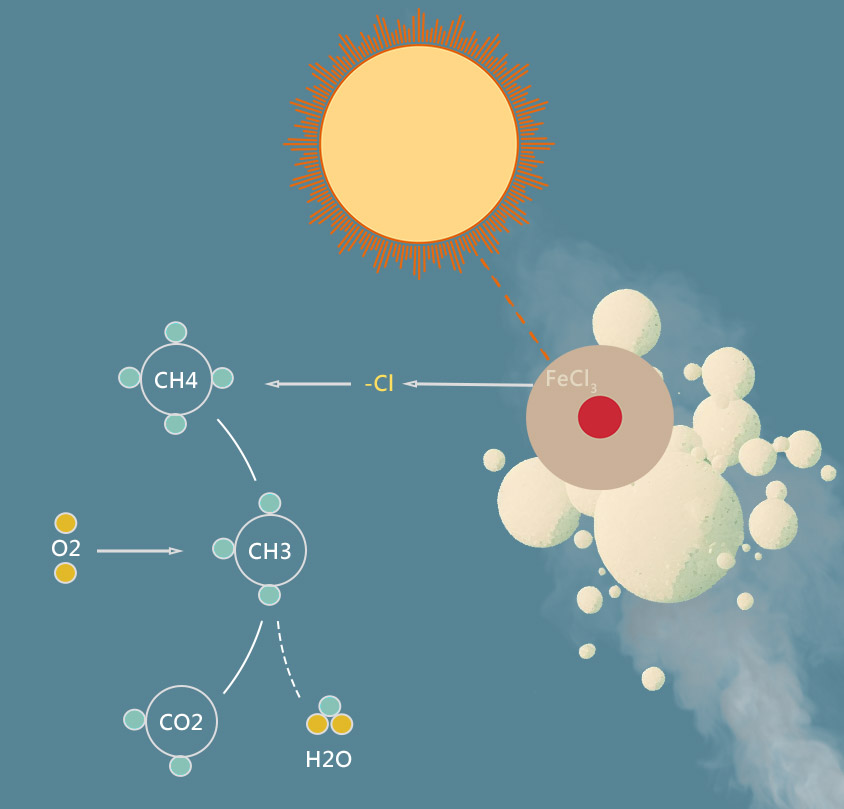
The iron salt aerosol hypothesis holds that sunlight will irradiate particles such as ferric chloride (FeCl3), producing chlorine radicals that break down methane in the air.
“There are all kinds of undesirable chlorinated compounds we wouldn’t want floating around the atmosphere,” Stanford’s Jackson says.
“Before we release chlorine radicals into bulk parcels of air, we need to do much more research on what else they will react with besides methane.”
Chlorine could also deplete ozone in the lower part of the atmosphere, which helps to produce the hydroxyl radicals that naturally break down the vast majority of the methane in the atmosphere, Mahowald says.
That means it’s not clear whether releasing these particles would actually destroy more or less of the greenhouse gas, she says.
Several researchers said these reactions probably wouldn’t have much of an impact on the protective ozone layer in the stratosphere but add that this possibility should be carefully evaluated as well.
It’s also possible the particles wouldn’t stay aloft long enough to make much of a difference in methane levels, or that the approach might work only under certain circumstances, at certain times, in certain places.
Methane is relatively dilute in the atmosphere, at about 1.9 parts per millionversus around 416 parts per million for carbon dioxide.
There are techniquesthat may allow researchers to assess the impact of iron particles on atmospheric methane at small scales.
But it could be challenging to reliably measure the effect of large-scale releases.
Even a particle plume that spans some tens of cubic kilometers “might appear as one pixel in a satellite map,” says Matthew Johnson, a professor of atmospheric chemistry at the University of Copenhagen who is involved in the Spark Climate-backed research effort.
“It would be difficult to see a signal, much less to accurately quantify it.”
That, in turn, could present an obstacle to verifying how much methane such an intervention removed, which would be key to the credibility of any methane removal credits analogous to the sort used in carbon dioxide markets.
There is also a risk in doing work that alters the atmosphere through a for-profit, venture-funded model: there could be financial pressure to claim that it’s working well even if it’s not, and to downplay any negative effects.
“Proposing that it should be commercialized is way beyond what the science yet supports,” Reinhardt wrote.
“And it’s not clear that commercialization will ever be an appropriate path to deployment.”
She says that the iron salt method may ultimately make more sense as a sort of “break glass in the case of emergency” tool if, as feared, continued warming triggers dangerous climate feedbacks that produce sharp increases in methane emissions from thawing permafrost, expanding wetlands, or other sources.
‘Under fire’
Fiekowsky argues that the risks associated with the iron salt method are overblown relative to the risk of massive methane releases in the future, which could produce rapid surges in warming.
“Aerosols wash out of the atmosphere in a couple days to a couple weeks, so the risk of notable damage is low,” he wrote.
“However, the risk of not using [iron salt aerosols] or other methane-oxidizing aerosols is high.”
Oeste says he expects the iron salt hypothesis will be vindicated.
Further, he expects that “simple lab and field tests” will be able to answer concerns about ozone depletion and other possible side effects.
“Most new theories [come] under fire,” he wrote.
Henkel-Wallace also defended Blue Dot Change’s plans, arguing that field experiments are how we can begin resolving some of the unknowns.
He said a for-profit model helps to ensure that the undertaking could be “self-sustaining.” But he stressed that the venture is still a long way from commercializing this approach, and won’t be able to if it can’t verify that the method removes methane.
He insists the company would simply cease spraying particles if there were unintended effects, since it is operating out of a sense of concern.
“I’m a human being on this planet too. I don’t want to put myself in danger,” he says.
“The integrity of the work should come through.”
The law of the sea
There are international conventions regulating activities in the open ocean that could have harmful effects on the marine environment.
Legal experts say they wouldn’t necessarily cover startups moving forward with small scale releases of iron salt particles, though the particulars may matter.
Some believe, however, that efforts in this area could spark an international reaction either way.
Following earlier commercial proposals to use iron to fertilize the oceans, nations sought to limit such endeavors to small-scale scientific research, through various statements and agreements among the parties to a UN convention and a pair of maritime dumping treaties.
They’re not legally binding, but “it’s safe to say that commercial marine geoengineering would be contrary to the spirit of the statements agreed to in international forums,” says Jesse Reynolds, an expert on international environmental policy and author of The Governance of Solar Geoengineering: Managing Climate Change in the Anthropocene.
Henkel-Wallace says Blue Dot Change will identify relevant regulatory authorities for any experiment, and that it will go beyond what’s strictly required before moving forward with any projects.
He says the company has reached out to former regulators and lawyers for guidance, and that Blue Dot Change should prepare an environmental impact report “to the standard that a group like the [Environmental Protection Agency] would have required, if it did have jurisdiction.”
“Over the past year or so we've been planning under the assumption that we can find a way to be subject to US or possibly EU environmental supervision,” he wrote in an email.
Henkel-Wallace says that the company also intends to run any proposed field trials or deployments past the Climate Restoration Safety and Governance Board, which “provides review, approval, and oversight for projects capable of making a significant impact towards restoring global CO2 and methane levels.”
Observers question the independence of the advisory board, however.
Fiekowsky “built” it and serves as chairman, and Blue Dot Change’s director of outreach is on it.
Several executives at the organization were also at one time involved in the Foundation for Climate Restoration.
“I don’t think anyone could make a credible case that this is an independent board,” says Danny Cullenward, policy director at Carbon Plan, who has studied problems with market-based climate policies and carbon markets.
He says this board resembles earlier for-profit efforts to set up favorable forms of oversight for carbon offsets markets.
“If your goal is to sell a product, you’ve got to say the product is real, good, and addresses concerns,” he says.
‘The light of day’
Henkel-Wallace says the board is “a stab” at setting up an independent regulatory regime to oversee such climate interventions, likening it to the institutional review boards that evaluate biomedical research involving humans.
But he says he shares these concerns and acknowledges that it’s “still early to know” if the board will be “legitimate.”
Fiekowsky says the board's purpose is “to ensure we restore the climate for future generations to flourish, and provide the public with accurate, relevant, and useful information.” He adds, “To succeed, projects must be safe, effective, legal, and ethical.”
Fiekowsky has made his own view on field experiments clear.
He argues that the risks would be minimal, pointing to the favorable findings of an earlier environmental impact study funded by Methane Action, a nonprofit he cofounded.
“No one can imagine a bad side effect that holds up to the light of day,” he says.
Societal permission
The University of Copenhagen’s Johnson says that researchers can learn a lot more about the potential and risks of this approach without adding iron particles into the atmosphere through field experiments.
Among other things, he said that researchers can sample and study the ample iron already in the air, as a result of natural sources like deserts and human activities such as shipping, heavy industry, and agriculture.
“Understanding these systems, already occurring in the atmosphere today, is the best way to move [iron salt aerosol] research forward,” he wrote in an email.
In fact, that work has already begun.
In October, crews aboard several commercial ships streaming across the Atlantic began a yearlong effort to collect ocean air, using handheld glass flasks connected to pumps that suck down samples.
They drop off crates filled with the flasks when the ships reach port, and the samples ultimately make their way to labs in the Netherlands for analysis as part of the research collaboration.
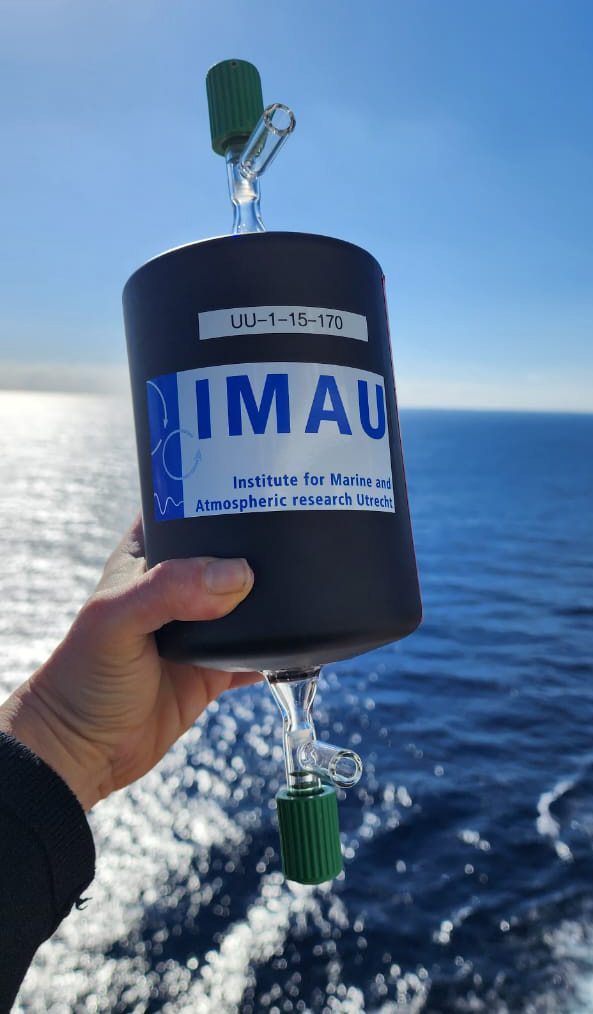
One of the glass flasks recently used to capture air samples at sea.
Courtesy of Maarten Van Herpen
Courtesy of Maarten Van Herpen
By studying the air samples back in the lab, the scientists hope to improve our basic understanding of atmospheric chemistry, explore whether the iron salt hypothesis holds up outside the lab, and assess what else these particles might do in the atmosphere, says Maarten van Herpen, executive director of Acacia Impact Innovation BV, a consulting firm that’s also involved in the effort.
Scientists fear that pushing ahead too hard and too fast in such a complex and touchy field could provoke a backlash against the basic concept, making it harder to carry out careful research on a tool that may well help reduce climate risks.
Indeed, some argue that premature commercial stabs at both iron fertilizationand solar geoengineering may have done just that.
Jackson stresses that this would be a drastic intervention fundamentally altering an essential global commons—and that simply demands exhaustive research and broad buy-in before plunging ahead.
“To make a dent at the million-ton scale, we will have to deploy these technologies widely,” he says.
“We will need a lot more information before we do that safely.
And we will need a lot more permission from the public to alter the Earth’s air.”
Links :
- WSJ : Emission Cuts Will Fail to Stop Climate Change. What to Do Then?
- The Guadian : Can geoengineering fix the climate? Hundreds of scientists say not so fast
- The Conversation : Geoengineering the ocean to fight climate change raises serious environmental justice questions
- New Scientist : Can we beat climate change by geoengineering the oceans?
- Science : Ocean geoengineering scheme aces its first field test
- The Maritime Executive : UK Launches Market Study on Carbon Capture Utilization and Storage
- New Scientist : We can suck CO2 from the air and store it in the ocean as baking soda
Monday, March 13, 2023
Sailors warned over ‘Britain’s newest island’ in Solent
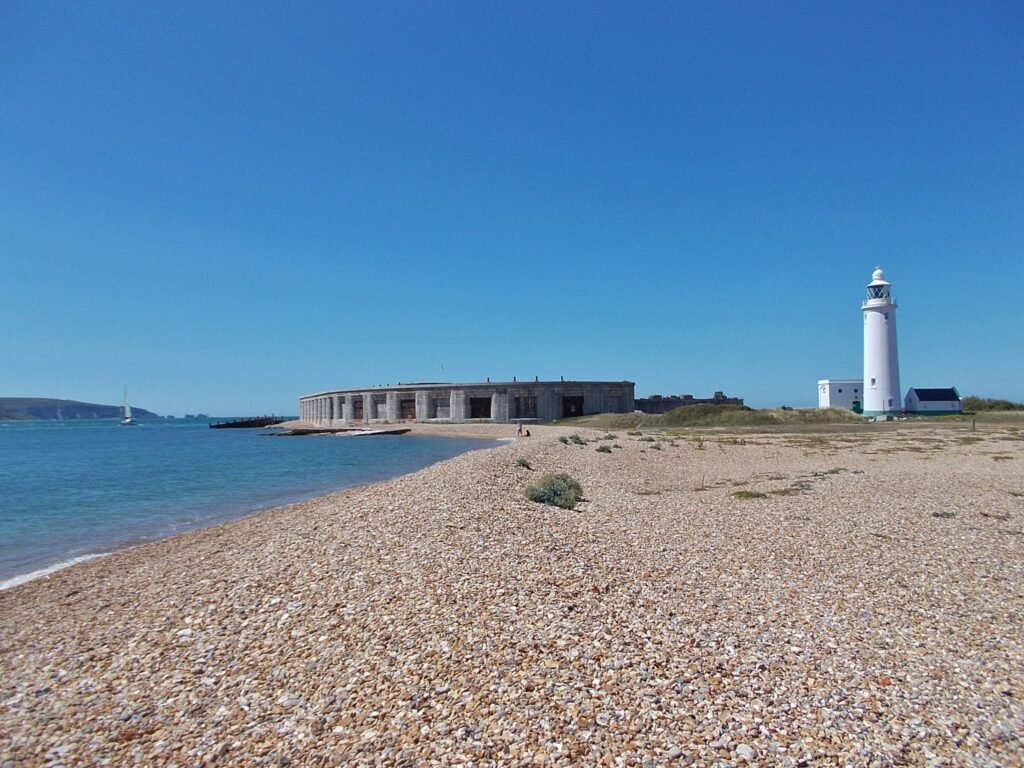
The castle and lighthouse at Hurst Point, Hampshire.
Image courtesy of ITookSomePhotos via Wikimedia Commons
From Marine Industry News
Lymington RNLI has issued a warning to sailors, after a ‘new island’ emerged in the Solent.
photo : Nick Boxall
The shingle bank, which measures a few hundred metres in length, emerges at low tide to the east of Hurst Spit near Lymington.
Watch out for this if you're on the water near to Hurst Spit in Lymington.
The RNLI are advising that current nautical charts for this area are now inaccurate.
The half-acre shoal appears to have formed naturally after work was done to protect nearby Hurst Castle from erosion.
Tonnes of shingle were dug up during the works, and experts have suggested these excavations could have caused a shift in tidal currents, resulting in the new bank forming.
Two plucky sailors recently planted a flag on the shingle outcrop, described by some as Britain’s newest isle, light-heartedly claiming the island as their own.
Two plucky sailors recently planted a flag on the shingle outcrop, described by some as Britain’s newest isle, light-heartedly claiming the island as their own.
The sailors tell media they are hoping to draw attention to the dangers the outcrop poses for visiting sailors.
Warning for sailors as 'new island' revealed near Hurst Castlehttps://t.co/WpKcbDknPa
— Advertiser & Times (@Lymingtontimes) February 24, 2023
Sailors Chris Fox and Nick Ryle set sail from the Royal Lymington Yacht Club to travel five miles to the shingle bar.
Speaking to local outlet A&T, Ryley says: “This island, so-called by us Lentune Island, has sprung up in a short time across the route most locals use when avoiding the tide whilst coming into the Solent on the ebb, and exiting the Solent on the flood.”
Speaking to local outlet A&T, Ryley says: “This island, so-called by us Lentune Island, has sprung up in a short time across the route most locals use when avoiding the tide whilst coming into the Solent on the ebb, and exiting the Solent on the flood.”
New spit at Hurst castle (Nick Boxall)
The pair chose the name Lentune Island in honour of Lymington’s original name — as recorded in the Doomsday book in 1086.
Speaking to The Times, Fox adds: “We had been monitoring the island for a while. It started as a strange lump in the sea and just kept growing.
“Nick had the idea that we should head out there and try to see exactly how big it had become. We were very careful, we sailed over in a small fishing boat with life jackets on and took every precaution. We were surprised by how big it was in the end, about 100 metres long and 20 metres wide.
“We took a flag for a bit of fun but in all seriousness, I think it is dangerous for any visiting sailors who don’t know the area very well.”
“Everyone has been talking about it, and we’re not really sure why it has emerged or what could be causing it,” he adds.
Speaking to The Times, Fox adds: “We had been monitoring the island for a while. It started as a strange lump in the sea and just kept growing.
“Nick had the idea that we should head out there and try to see exactly how big it had become. We were very careful, we sailed over in a small fishing boat with life jackets on and took every precaution. We were surprised by how big it was in the end, about 100 metres long and 20 metres wide.
“We took a flag for a bit of fun but in all seriousness, I think it is dangerous for any visiting sailors who don’t know the area very well.”
“Everyone has been talking about it, and we’re not really sure why it has emerged or what could be causing it,” he adds.
Two yachtsmen have planted a flag on a new British “island” that formed off the south coast from freshly deposited shingle https://t.co/3mmW7lTzKX
— The Times and The Sunday Times (@thetimes) February 28, 2023
Alistair Mackay, manager of Lymington Lifeboat Station, told The Times that he is also trying to raise awareness to protect visiting sailors.
“It definitely will be a problem; in storm conditions, being grounded on the shingle would be disastrous,” he says. “You wouldn’t be able to swim to shore, and the rocks and waves battering the boat would cause real damage.”
The UK Hydrographic Office says it is aware of the situation and is adding a warning onto its charts.
In a statement, English Heritage said: ‘The Hurst Spit and the wider coastal environment around Hurst Castle is complex and ever-changing, facing issues such as longshore drift, rising sea levels and more frequent storms.
‘Any work undertaken to care for Hurst Castle is carried out as part of the Beach Management Plan and in close discussion with those statutory bodies responsible.’
Links :
Sunday, March 12, 2023
Big C Atlantic Challenge
Big C Atlantic challenges latest sea trials held offshore at Whitehaven in Feb 2023. Big C Atlantic Challenge is a vessel designed and constructed to take on the Atlantic Ocean !
Its been designed and initially built by Tom McNally who held the record back in '93, its now been shortened and modified to fit my frame.
Were heading out from Sy John's Newfoundland and sailing her back to the UK and bringing the world record with me !!

%20Islands.jpg)

